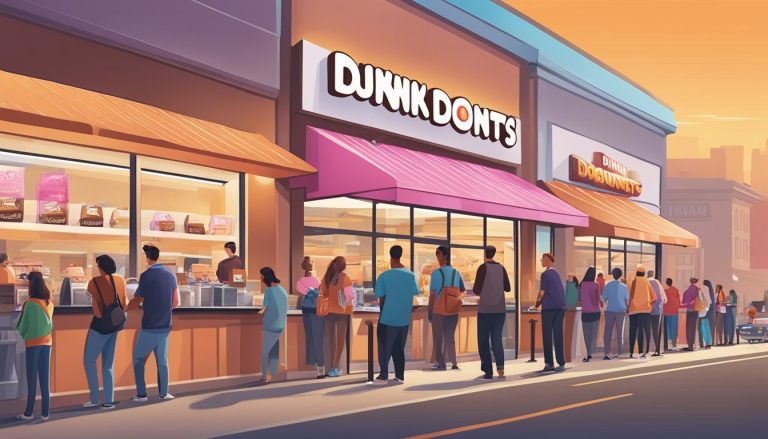In 1948, a small coffee shop called “Open Kettle” opened its doors in Quincy, Massachusetts. The brainchild of William Rosenberg, this modest establishment served donuts for five cents and premium coffee for ten cents. Little did anyone know that this humble beginning would lead to the creation of a global breakfast empire.
Two years after its inception, Rosenberg renamed his restaurant “Dunkin’ Donuts.” This simple name change marked the birth of a brand that would revolutionize the fast-food industry and become synonymous with quick, affordable breakfast options. The focus on quality coffee and fresh donuts quickly resonated with customers, setting the stage for rapid expansion.
As Dunkin’ grew, it adapted to changing consumer preferences. In the 1990s, the company shifted its focus towards coffee, expanding its beverage offerings to compete with premium coffee chains. This strategic move, combined with its commitment to convenience and affordability, solidified Dunkin’s position as a leader in the breakfast market.
Founder’s Vision and the First Steps
William Rosenberg’s entrepreneurial spirit and commitment to quality laid the foundation for Dunkin’ Donuts. His vision transformed a small Massachusetts coffee shop into a global breakfast empire.
From William Rosenberg to ‘Open Kettle’
William Rosenberg began his foodservice career in 1946 with Industrial Luncheon Services. The company provided food and coffee to factory workers in Boston. Rosenberg noticed coffee and donuts were his most popular items.
In 1948, he capitalized on this insight by opening a restaurant in Quincy, Massachusetts. He named it “Open Kettle” and focused on serving fresh coffee and donuts.
The shop quickly gained popularity among local residents and workers. Rosenberg’s emphasis on quality and customer service set his business apart from competitors.
The Birth of Dunkin’ Donuts
In 1950, Rosenberg renamed his restaurant “Dunkin’ Donuts”. The new name reflected his goal to make and serve the freshest, most delicious coffee and donuts quickly and courteously.
Rosenberg’s vision included modern, well-merchandised stores. This approach resonated with customers and led to rapid growth.
In 1955, the first Dunkin’ Donuts franchise opened. This marked the beginning of the brand’s expansion beyond Quincy. Within a decade, the number of Dunkin’ Donuts locations grew significantly.
Rosenberg’s commitment to quality and customer satisfaction became the cornerstone of Dunkin’ Donuts’ success. His vision continues to guide the company’s operations today.
Brand Evolution and Menu Expansion
Dunkin’ underwent significant transformations since its founding, adapting its brand identity and expanding its menu offerings to meet changing consumer tastes. These strategic shifts played a crucial role in the company’s growth and success.
Rebranding and the Iconic Pink and Orange Logo
In 1960, Dunkin’ Donuts introduced its now-famous pink and orange color scheme. This vibrant combination helped the brand stand out in a crowded market. The colors became synonymous with the Dunkin’ experience, appearing on storefronts, packaging, and advertisements.
In 2006, the company unveiled a new logo featuring a coffee cup alongside the brand name. This update emphasized Dunkin’s growing focus on beverages beyond just donuts.
The most significant rebranding occurred in January 2019 when the company officially dropped “Donuts” from its name, becoming simply “Dunkin'”. This change reflected the brand’s evolution into a broader beverage and food service establishment.
Menu Diversification: Beyond Coffee and Donuts
Dunkin’ steadily expanded its menu offerings beyond its original coffee and donuts. In the 1980s, the company introduced bagels and muffins, catering to customers seeking more diverse breakfast options.
Breakfast sandwiches joined the menu in the 1990s, featuring combinations of eggs, cheese, and meats on bagels, croissants, or English muffins. This move positioned Dunkin’ as a direct competitor to fast-food chains in the morning meal segment.
In response to growing health consciousness, Dunkin’ added lighter options like wraps and smoothies. The company also introduced gluten-free and vegan items to accommodate various dietary preferences.
Launch of Signature Products
Dunkin’ developed several signature products that became customer favorites. In 1972, the brand introduced Munchkins donut holes, a portable and shareable treat that quickly gained popularity.
The Coolatta, a frozen beverage line launched in 1997, became a summer staple. Available in various flavors, it helped Dunkin’ compete in the iced drink market.
In 2006, Dunkin’ launched its espresso line, featuring lattes and cappuccinos. This move allowed the brand to tap into the growing premium coffee market and compete with specialty coffee shops.
The company also introduced seasonal offerings like pumpkin-flavored coffee and holiday-themed donuts, creating excitement and driving repeat visits throughout the year.
Franchising: A Catalyst for Growth

Dunkin’ Donuts’ adoption of franchising in 1955 propelled the company from a local Massachusetts coffee shop to a global breakfast empire. This strategic move allowed for rapid expansion across the United States and eventually worldwide.
Adopting the Franchise Model
In 1955, Dunkin’ Donuts opened its first franchise location in Worcester, Massachusetts. This decision came as founder William Rosenberg sought to expand while managing costs. The franchise model allowed entrepreneurs to open their own Dunkin’ Donuts shops under the brand’s guidelines.
Franchisees received training, support, and the right to use Dunkin’s recipes and brand name. In return, they paid fees and royalties to the parent company. This system proved mutually beneficial, enabling rapid growth without requiring extensive capital investment from Dunkin’ Donuts itself.
Expanding the Dunkin’ Empire Nationally
The franchise model fueled Dunkin’ Donuts’ expansion across the United States. By the 1960s, the chain had grown to over 100 locations. This growth continued steadily over the following decades.
Dunkin’ focused on maintaining consistency across franchises. They ensured each location offered the same menu items, quality, and customer experience. This standardization helped build brand recognition and customer loyalty nationwide.
The company also adapted to regional preferences, allowing franchisees some flexibility in menu offerings. This strategy helped Dunkin’ Donuts appeal to diverse markets across the country.
Going Global: International Franchising
In the 1970s, Dunkin’ Donuts began its international expansion through franchising. The company’s first international location opened in Japan in 1970. This marked the beginning of Dunkin’s global presence.
The franchise model proved equally successful abroad. Dunkin’ Donuts adapted its offerings to suit local tastes while maintaining core brand elements. For example, in India, the menu includes spiced tea and vegetarian options.
Today, Dunkin’ operates in over 40 countries. The company’s success in international franchising has made it a case study in global expansion strategies. Dunkin’ continues to seek new markets, leveraging its franchise model to grow its worldwide presence.
Competition and Market Positioning

Dunkin’ faces stiff competition in the breakfast and coffee markets, driving the company to innovate and refine its positioning. The brand has adapted its strategies to differentiate itself from rivals and maintain a strong market presence.
Rivals in the Breakfast Arena
Dunkin’ contends with several major competitors in the breakfast space. Starbucks stands out as its primary rival, especially in the coffee segment. Krispy Kreme provides strong competition in the donut category. Local coffee shops and regional chains also vie for market share.
Dunkin’ has carved out a niche by emphasizing quick service and affordable prices. This approach appeals to busy professionals and budget-conscious consumers seeking a fast breakfast option.
The company’s wide range of menu items, from donuts to sandwiches, helps it compete against more specialized rivals.
Innovation in the Face of Competition
To stay ahead, Dunkin’ has consistently introduced new products and services. The brand expanded its coffee offerings beyond traditional drip coffee to include espresso-based drinks and cold brew options.
Dunkin’ also embraced digital innovation. The company launched a mobile app for ordering and payments, enhancing convenience for customers.
Menu diversification has been another key strategy. Dunkin’ introduced healthier options like oatmeal and egg white sandwiches to appeal to health-conscious consumers.
The brand has also experimented with store formats, including drive-thru only locations and smaller footprint stores for urban areas.
Comparative Study: Dunkin’ vs. Starbucks
Dunkin’ and Starbucks target different market segments. Dunkin’ positions itself as a more affordable, fast-service option, while Starbucks focuses on premium products and a café experience.
Price points differ significantly:
| Item | Dunkin’ | Starbucks |
|---|---|---|
| Medium Latte | $3.49 | $4.45 |
| Medium Hot Coffee | $2.09 | $2.45 |
Dunkin’ emphasizes its coffee quality through marketing campaigns like “America Runs on Dunkin’.” Starbucks, in contrast, promotes a more upscale image and focuses on customization.
Store aesthetics also differ. Dunkin’ opts for bright, energetic interiors, while Starbucks cultivates a more subdued, coffeehouse atmosphere.
Cultural Impacts and Marketing Strategies
Dunkin’ has left an indelible mark on American culture through its innovative marketing campaigns and iconic slogans. The company’s strategic approach has transformed it from a local coffee shop into a beloved national brand.
‘America Runs on Dunkin’: The Marketing Genius
Dunkin’ launched its “America Runs on Dunkin'” campaign in 2006, perfectly capturing the brand’s role in fueling the nation’s daily routines. This slogan resonated with customers across the country, emphasizing Dunkin’s commitment to providing quick, quality coffee and breakfast options.
The campaign featured relatable scenarios of everyday Americans starting their day with Dunkin’ products. It highlighted the brand’s accessibility and its understanding of customers’ busy lifestyles.
Dunkin’ leveraged various media channels to spread its message, including television commercials, radio spots, and billboards. The company also embraced digital marketing, utilizing social media platforms to engage with younger audiences and maintain relevance in the changing media landscape.
Fred the Baker and Iconic Slogans
One of Dunkin’s most memorable marketing strategies centered around the character of Fred the Baker, portrayed by actor Michael Vale. The “Time to Make the Donuts” commercials featuring Fred became a cultural phenomenon in the 1980s and 1990s.
Fred’s catchphrase, “Time to make the donuts,” emphasized Dunkin’s commitment to freshness and hard work. The character appeared in over 100 commercials, becoming synonymous with the brand’s dedication to quality.
Other notable slogans included “Dunkin’ Donuts and you’re dunkin’,” which played on the brand name, and “You’re kin’ to Dunkin’,” fostering a sense of familiarity and belonging among customers.
Dunkin’s Imprint on American Culture
Dunkin’ has become deeply ingrained in American culture, particularly in the Northeast where it originated. The brand’s ubiquity has made it a symbol of everyday American life.
Dunkin’s orange and pink color scheme is instantly recognizable, appearing on everything from coffee cups to storefront signs. This visual branding has become an iconic part of the American landscape.
The company’s influence extends beyond food and drink. Dunkin’ has entered the lexicon, with phrases like “Dunkin’ run” becoming common parlance for a quick coffee break. The brand has also been featured in numerous TV shows and movies, further cementing its place in popular culture.
Dunkin’s evolution from a donut shop to a beverage-led, on-the-go brand reflects changing American consumer habits. Its ability to adapt while maintaining its core identity has ensured its continued relevance in the fast-paced American lifestyle.
Innovation and Future Direction

Dunkin’ has continually adapted to changing consumer preferences and market trends. The company’s focus on innovation and sustainability has positioned it for future growth and success.
Pioneering New Trends and Technologies
Dunkin’ has embraced technological advancements to enhance customer experience. The company launched a mobile app for easy ordering and payment, streamlining the purchase process for busy customers.
Digital kiosks in stores allow for faster, more accurate orders. Dunkin’ has also experimented with food trucks, bringing their products directly to consumers at events and high-traffic areas.
The introduction of Coolattas in the 1990s marked Dunkin’s entry into the frozen beverage market. This innovative drink quickly became a customer favorite, especially during summer months.
Dunkin’ was an early adopter of iced coffee, recognizing the growing demand for cold beverages. The company now offers a wide variety of iced coffee options, including cold brew and nitro cold brew.
Sustainability and the Future of Dunkin’
Dunkin’ has made significant strides in environmental responsibility. The company committed to eliminating foam cups by 2020, replacing them with double-walled paper cups.
They’ve also focused on sourcing sustainable ingredients. Dunkin’ aims to use 100% responsibly sourced coffee by 2025, supporting farmers and reducing environmental impact.
Energy-efficient equipment and green building practices are being implemented in new and renovated stores. These efforts reduce Dunkin’s carbon footprint and operating costs.
The company is exploring plant-based menu options to cater to changing dietary preferences. Dunkin’ partnered with Beyond Meat to offer a plant-based breakfast sandwich, appealing to health-conscious consumers.
Legacy and Influence

Dunkin’ Donuts has left an indelible mark on the breakfast and coffee industry, shaping consumer preferences and business practices worldwide. Its impact extends far beyond its origins as a small coffee shop in Massachusetts.
The Legacy of Dunkin’ Donuts
Dunkin’ has become synonymous with quick, affordable breakfast options and quality coffee. The brand’s classic donuts, including the Boston Kreme and jelly-filled varieties, have become cultural icons in the United States.
Dunkin’s expansion into international markets, including Japan, has demonstrated its global appeal. The company’s ability to adapt its menu to local tastes while maintaining its core offerings has been key to its success.
The chain’s commitment to consistency and quality has set a standard for fast-food breakfast options. Dunkin’ has also played a significant role in popularizing coffee consumption outside of traditional coffee shops.
Dunkin’ Donuts’ Influence on the Industry
Dunkin’ pioneered the concept of fast-food breakfast, inspiring competitors to develop similar offerings. Its focus on convenience and speed has influenced how many Americans start their day.
The company’s success has led to the proliferation of donut shops and coffee chains across the United States and globally. Dunkin’s menu innovation, particularly in beverages, has pushed other chains to expand their drink options.
Dunkin’s franchise model has become a blueprint for success in the fast-food industry. Its emphasis on franchisee support and standardized operations has influenced many other chains’ business practices.
The brand’s marketing strategies, including its iconic “America Runs on Dunkin'” slogan, have set trends in food industry advertising and brand positioning.




